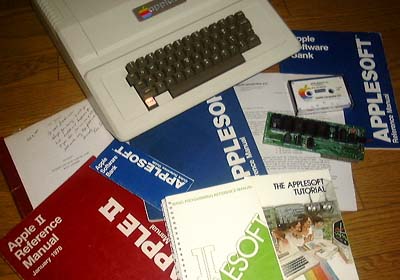
My AppleII Notes-18
01/1/14 Transformation
of Applesoft manuals

Apple II BASIC is a dialect of Microsoft
BASIC brought out by Apple and called Applesoft BASIC (10K BASIC).
Applesoft BASIC was an
improvement on Microsoft Basic and came on a standard ROM card that was
installed in the Apple II Plus released in 1979. The card replaced Wozniak's
Integer BASIC (6K BASIC) card. Applesoft, by using an auto start ROM, was ready
to use when the Apple II Plus was powered on. From 1977 to 1978 Applesoft was
refined by Apple and
became Applesoft II. At
this time, it was decided that the Applesoft II manual
along
with other Apple manuals would all be ring-binder type manuals. Several of
Apple’s manuals were revised and released at the same time.
The notes below give some details and background to these manuals. (See
Apple II Notes My-6 )
Lettter Dated Nov. 4,1977
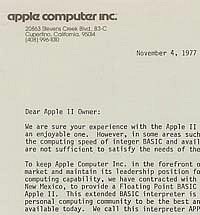 Part of a letter from Apple announcing to Apple II users that Applesoft was available. (1977/11/4) |
Apple II users
received this letter from Apple on November 4, 1977, stating that Applesoft,
which had been announced in April, had been duly completed in June. (Photo
on the left)· The letter
contained the following information: Apple II
Integer BASIC did not exhibit the necessary performance sufficient for
scientific fields
and other areas. In order to enhance the
leadership and reliability of the Apple II personal computer, Apple
had
entered into a tie-up with Microsoft of Albuquerque for the Apple II to use
a floating point BASIC interpreter software package. · This version of BASIC
called "Applesoft" had 81 commands and was a very powerful interpreter that
used 10K of RAM.
If few
bugs were found, Apple promised to release the interpreter in a ROM as a
firewire card.
|
 |
The
photo on the left is of the enclosed manual and quick reference guide: the
so-called
Blue Book.
|
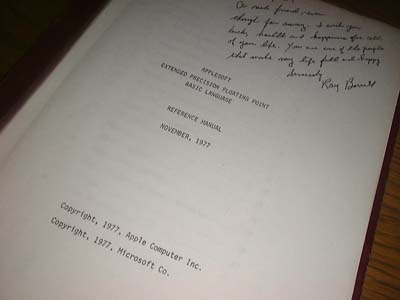
Applesoft Manual (Draft) The
cover page is signed by a US dealer who
handled Apple products starting with the Apple I. I asked him to sign it because
he is mentioned in the book "Fire in the Valley".
二種類の"Blue Book"
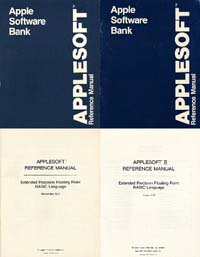 Left: Applesoft Manual (77/11) Right: Applesoft II Manual (78/8) |
In Applesoft, the hi-res graphics were deleted
due to memory restrictions, and the lo-res graphics were significantly
different from Wozniak’s Integer BASIC. Applesoft II Reference Manual A2L0006 US $ 7.5
Applesoft II Cassette w / Manual
A2T0004
US $ 20
Applesoft II Firmware Card
A2B0009
US $ 200 |
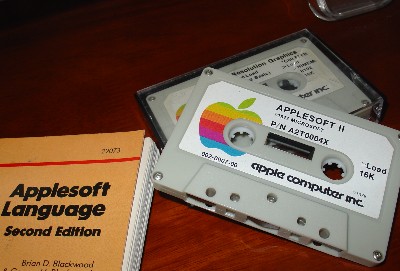
 Integer BASIC Programming Manual partial back cover of manual with "Written by Jef Ruskin" credit clearly seen |
J eff Ruskin, a proponent of the concept of the Macintosh computer and also known as the conductor of the San Francisco Symphony Orchestra, was involved with Apple manuals, starting with the Apple – 1. In 1977, he moved to Apple from a manual production company. He became head of the manual department. It looks like the ring-binder "Integer BASIC Programming Manual” published in the first half of 1978 was the first manual produced after he had responsibility for the department.This manual contained the following changes, and these improvements determined the direction in which the style of Apple manuals went. · Eliminate technical terms as much as possible and write using easy-to-understand language. · Introduce graphics frequently and color printing.
·
Use a ring-binder for ease
In the book titled "The Little Kingdom", regarding to Disk II manual, an episode is related in which Michael Scott ships an inadequate manual with a product to a very demanding customer in southern California. The subsequent role that the user played in improving Apple's manuals would appear to be significant. |
Applesoft II Manualの改訂
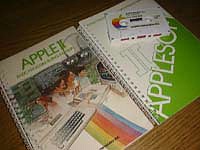 Ringbinder manuals created with Jeff Ruskin's ingenuity. Left: integer BASIC Programming Manual Right: Applesoft II BASIC Programming Reference Manual |
In
keeping with these improvements, the second generation Blue Book manual
for Applesoft II, which was created in August 1978, was revised and
changed to a ringbinder manual compliant with Apple's manual guidelines.
Applesoft
II’s Bluebook is therefore a rare manual because it had a very short
period of distribution.
|